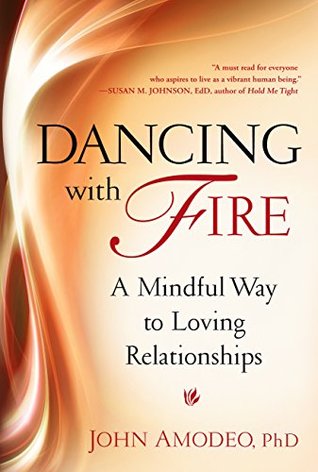Kindle Notes & Highlights
by
John Amodeo
Read between
August 28, 2016 - March 24, 2017
we may then express what we are experiencing in a manner that is unguarded, tender, and dignified. Speaking in a way that is congruent with what we’re experiencing can actually feel good, while also dramatically improving our chances of being heard.
Dōgen,
“To be enlightened is to be intimate with all things.”
As we reside in our undefended heart and show ourselves to others, we send signals that help them feel safer coming toward us.
We exhibit controlling behavior when we feel inwardly out of control.
our capacity for intimacy requires trusting ourselves and trusting life.
Creating loving relationships requires a quiet kind of power, the gentle strength to be open.
attitude of gracious allowing
As Zen teacher John Tarrant puts it, “Noticing is a practice of love. You don’t have to exclude, extinguish, or dislike anything.”
If we limit mindfulness to a narrow zone, perhaps by noting feelings and sensations but never allowing ourselves to feel them, we may find a serenity that teeters on shaky ground.
A hundred times every day I remind myself that my inner and outer life depends on the labors of other men, living and dead, and that I must exert myself in order to give in the measure as I have received and am still receiving. —Albert Einstein
An essential part of living a spiritual life is paying attention to the consequences of our actions and words.
Spiritual growth is a spiral staircase, not a straight line to liberation.
It is about accommodating feelings, not transcending them.
Being overly ambitious in psychotherapy, intimate relationships, or spiritual life is counterproductive, like opening the oven every few minutes to see how well our cake is baking.
Just as our body is constantly changing, what we call “I” is always in process. There is no ultimate truth to “get,” no identity to grasp, no final resting place. There may be times of stabilization, but we’re always moving forward—
integrating our humanity into our spirituality and our spirituality into our humanity.
We are an evolving process, an ongoingness.
we see ourselves as an awakening being, not an awakened one.
As Buckminster Fuller was fond of saying, “I seem to be a verb.”
The word “feelings” is a shorthand term for something enormously complex—a blend of emotions, sensations, and meanings that arise as a result of being alive.
A mindfulness practice that connects us with our feelings is an antidote to controlling other people or ourselves. Rather than telling others what to do or how to be, we can tell them how they affect us. Instead of being critical and blaming, we expose the tender feelings that have been poked.
A gentle look, smiling eyes, and a warm heart emanating from our quiet depths invite people to savor a precious moment of uplifting contact.
One of the joys of spiritual life is luminous engagement.
A more helpful inquiry might be, “What is the art through which we might release what constricts us? How can we create an inner climate that fosters fluidity, freedom, and connection?”
Eugene Gendlin, a philosopher, psychologist, and researcher at the University of Chicago,
Rather than scrambling to figure things out in their heads, these naturally gifted clients slowed down their speech, sensed inwardly with curiosity, and waited for words, images, insights, or meanings to arise that resonated with their most deeply felt experience. Uncovering what was freshly alive within themselves, they felt more connected, whole, and peaceful.
“Focusing is not about feeling as intensely as possible. Focusing is about keeping your feelings company.”
Similar to meditation, Focusing is a way of being present that is non-striving and non-evaluative.
Jason Siff. In his helpful book Unlearning Meditation, he encourages an “open, flexible, minimally structured approach to meditation,”12 allowing thoughts, feelings, longings, or any other phenomena to arise as they will and consciously choosing to explore them if that seems useful.
Ego functions include thinking, planning, and orienting ourselves in ways that help us survive and thrive in the world.
We realize that we are not a person who needs fixing, but a process that invites embracing.
“Who I am is simply experiencing itself.”
Ann Weiser Cornell and Barbara McGavin emphasize phrases such as “part of me feels” or, even more helpful, “something in me feels” sad, afraid, constricted (or whatever) rather than saying, I feel sad, afraid, or constricted.
it conveys that there is more to us than our passing feelings and allows a spacious mindfulness around our experience,
non-evaluative presence
The calming effect of being heard frees us from the tug of a longing that is now being met, thereby easing our movement toward awakening.
there is a difference between being judgmental and being discerning. The former elevates us to a morally superior pedestal; the latter simply sees reality clearly.
Can we respect the wisdom of teachers while also acknowledging that they are human and flawed like everyone else?
By mindfully refining and trusting our own felt sense of things, we can sort out what we can accept, where we disagree, and what we want to ponder further.
Jack Kornfield offers this illuminating view: For almost everyone who practices, cycles of awakening and openness are followed by periods of fear and contraction.


